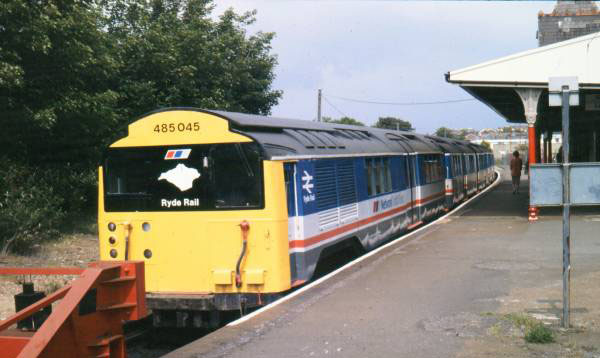- British Rail Class 485
Infobox EMU
name = British Rail Class 485
imagesize = 300px
caption = Class 485 no. 485045 atShanklin railway station , current terminus of the Island Line.
background = #243D5C
Manufacturer =Metro Cammell ,Union Car ,Cammell Laird
Operator =Network SouthEast
Formation = 4 cars per trainset
InService = 1923 onLondon Underground
1967 - 1992 on Island Line
Weight = 94 t
Capacity = 132 seats
MaxSpeed = 45 mph 72 km/h
Gauge = 1,435 mm
Voltage = 630 V DC3rd rail TheBritish Rail Class 485 (or 4Vec)electrical multiple unit s were original built for the London Electric Railway from 1923-31 as their 'Standard' tube stock. They were purchased by British Rail in 1967 and transported to theIsle of Wight to work 'mainline' services on the newly electrified Ryde to Shanklin line. At the time the units had already worked for over forty years on theLondon Underground , but their introduction allowed the final steam locomotives on the line to be withdrawn.Six four-cars were refurbished by BR's
Stewarts Lane depot in 1966-67. The units were initially classified Class 452 and numbered 041-046, later reclassified Class 485 and numbered 485041-046. Each unit was formed of a driving motor, two intermediate trailers, and a second driving motor. Thus, the formation was DMBSO+TSO+TSO+DMBSO. Some of the intermediate trailers were former driving trailers, with the cabs locked out of use.When introduced, the units carried all-over BR blue livery. This progressed to standard blue/grey livery in the 1970s, and finally some units received
Network SouthEast 's blue livery with red and white stripes, following its introduction in 1986.Electric services on the Isle of Wight commenced on
20 March 1967 . In service, it was common for the 4Vec units to work in combination with a 3Tis unit, such that a train was formed of seven coaches."Vectis" is the Roman name for theIsle of Wight .Due to the proximity to the sea, the units suffered from bad corrosion damage. By the mid-1980s it was clear that the units needed replacing. The replacements came from the 2-car Class 483, which were also rebuilt from former
London Underground stock, namely 1938 tube stock. These new units were introduced from 1989. The last 3Tis and 4Vec units were withdrawn from service in 1992.Upon retirement from Isle of Wight services, several 4Vec vehicles were sold back to London Underground for eventual restoration as part of an operational 'Standard' stock museum unit. These are listed below:
*DMBSO no. 2 (from set 485041) - previously LT 3706
*DMBSO no. 7 (from set 485044) - previously LT 3209
*DTSO no. 27 (from set 485043) - previously LT 5279
*TSO no. 44 (from set 485044) - previously LT 7281
*TSO no. 49 (from set 485044) - previously LT 7296Fleet Details
Details of the original 1967 formations are shown below. TSO vehicles marked with an asterisk (*) were originally DTSO vehicles with the cab locked out of use.
External links
* [http://www.therailwaycentre.com/Recognition%20Tech%20Data%20EMU/EMU_485_486.html Photographs and further details of 4Vec and 3Tis units.]
* [http://www.semgonline.com/gallery/class485_486_01.html Photographs of Class 485 and 486 units.]
Wikimedia Foundation. 2010.
